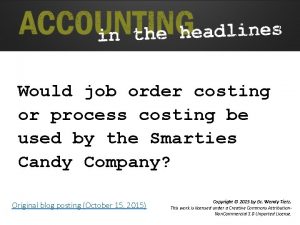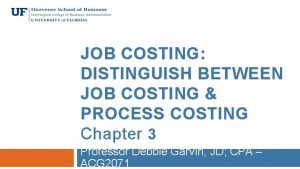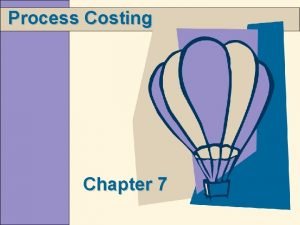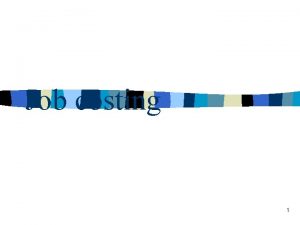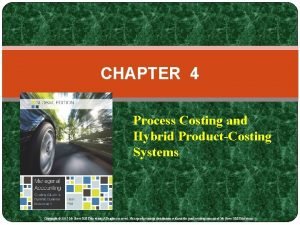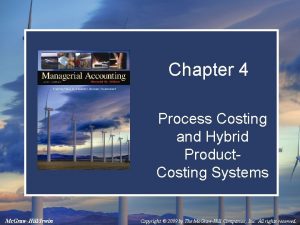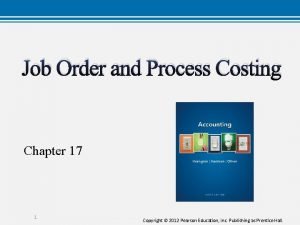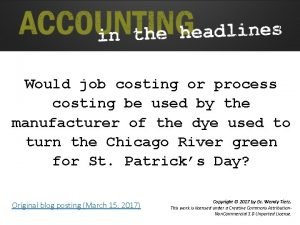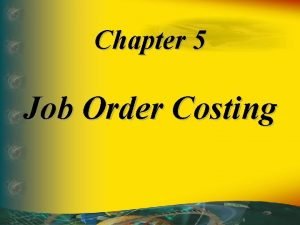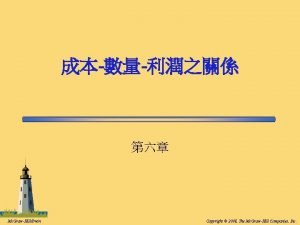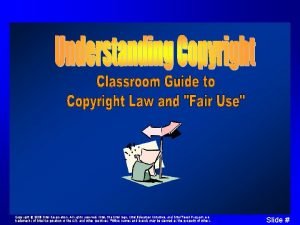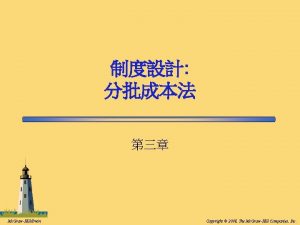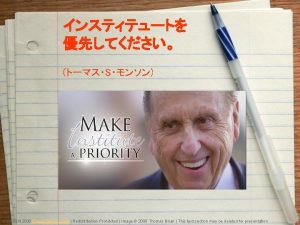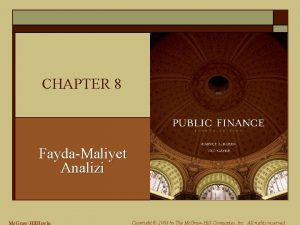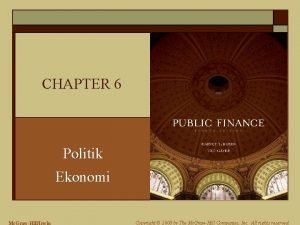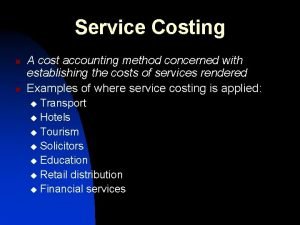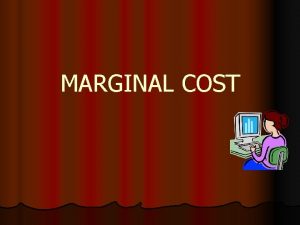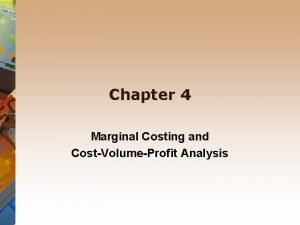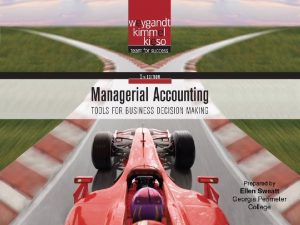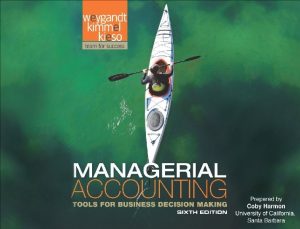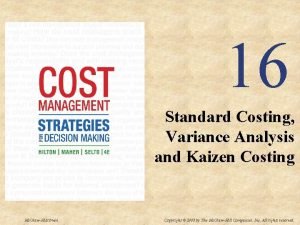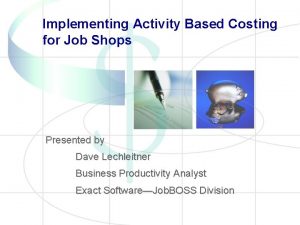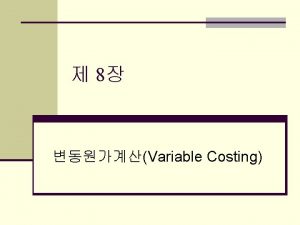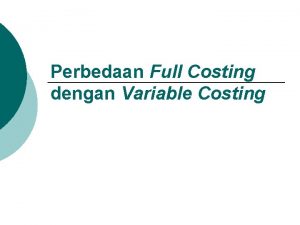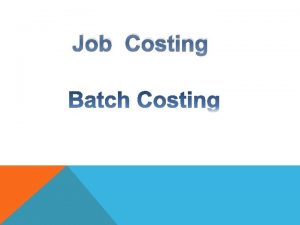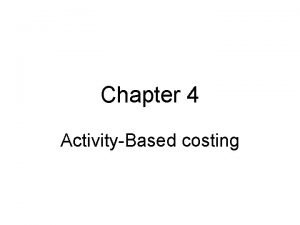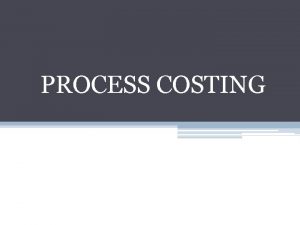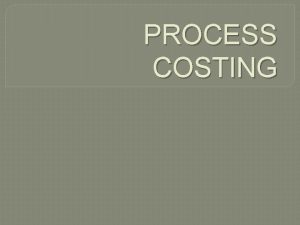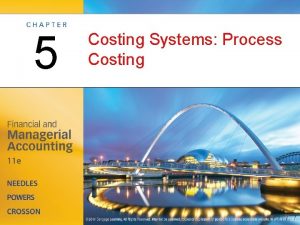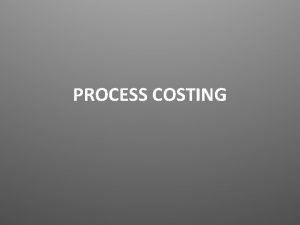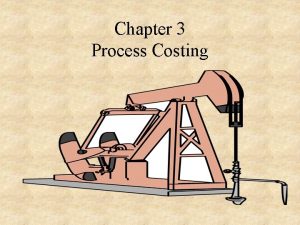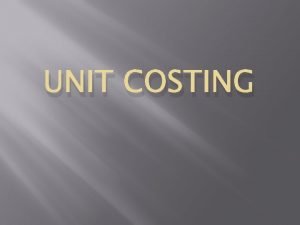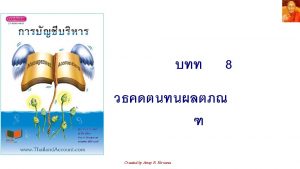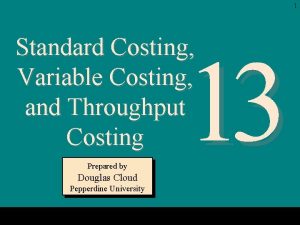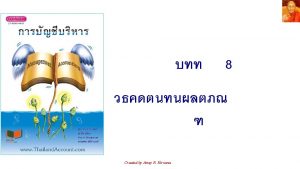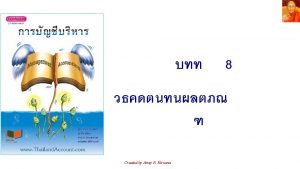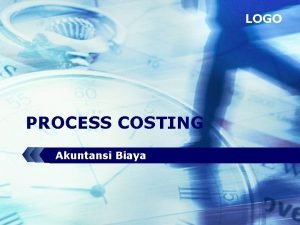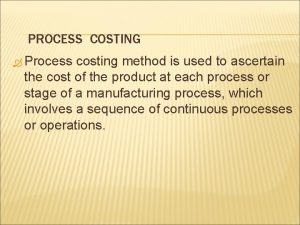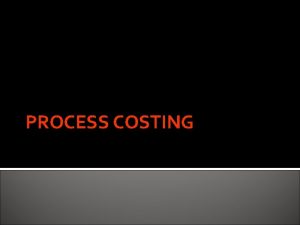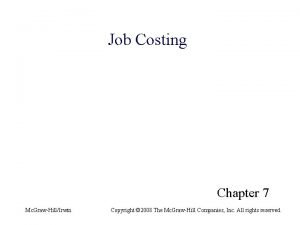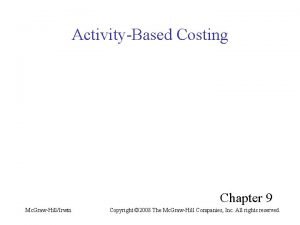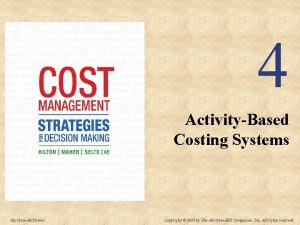Process Costing Chapter 8 Mc GrawHillIrwin Copyright 2008

































- Slides: 33

Process Costing Chapter 8 Mc. Graw-Hill/Irwin Copyright © 2008 The Mc. Graw-Hill Companies, Inc. All rights reserved.

Learning Objectives: 1. Explain the concept and purpose of equivalent units. 2. Assign costs to products using a five-step process. 3. Assign costs to products using weighted-average costing. 4. Prepare and analyze a production cost report. 5. Assign costs to products using first-in, first-out (FIFO) costing. 6. Analyze the accounting choice between FIFO and weightedaverage costing. 7. Know when to use process or job costing. 8. Compare and contrast operation costing with job costing and process costing. 8 -2

Job versus Process costing Job Costing Direct Materials, Direct Labor, and Factory Overhead Job 121 Job 122 Is there a conceptual difference between job costing and process costing? Finished Goods Cost of Goods Sold Job 123 Process Costing Direct Materials, Direct Labor, and Factory Overhead Process A Process B Process C 8 -3

Choosing between Job Order and Process Costing LO 7 Know when to use process or job costing. Job Costing An accounting system that traces costs to individual units or to specific jobs, contracts, or batches of goods. Process Costing An accounting system used when identical units are produced through a series of uniform production steps. Custom Homes Cornflakes Movies Beverages Services Paint 8 -4

Equivalent Units LO 1 Explain the concept and purpose of equivalent units. When manufacturing a product using a continuous process we assume all units have the same costs. Problem: Some units are not completed Answer: Equivalent units 8 -5

Equivalent Units, Continued. . . Equivalent Units (Eq. U) Number of complete physical units to which units in inventories are equal in terms of work done to date. . 3 + . 75 Number of units in process 3 + 3 . 9 Average x Completion of 65% x . 65 = = = Average Can is 65% Complete Eq. U 1. 95 Eq. U 8 -6

Product Costing in a Process Industry LO 2 Assign costs to products using a five-step process. Five steps to Costing a Product 1. Measure the physical flow of resources. 2. Compute the equivalent units of production. 3. Identify the product costs for which to account. 4. Compute the costs per equivalent unit. 5. Assign product cost to batches of work. 8 -7

Assumptions about Costs in WIP How do we account for beginning balance and current period activities and costs? One Method: weighted average An inventory method that for product costing purposes combines costs and equivalent units of a period with the cost and equivalent units in beginning inventory. Beginning Balance Prior Period Unit costs are a Current Period weighted average 8 -8

Assumptions about Costs in WIP, Continued. . . Another Method: FIFO An inventory method whereby the first goods received are the first ones charged out when sold or transferred. Prior Period Current Period We assume units from last period are completed and transferred out first. Prior Period then Current Period First-in, First-out (FIFO) 8 -9

8 -10

Example: Process Costing – Torrance Tape (2 T) Torrance Tape – Compounding Department Units Materials Costs Conversion Costs WIP March 1 20, 000 a $16, 160 $8, 126 March activity 92, 000 84, 640 213, 634 112, 000 $100, 800 $221, 760 Total Transferred out 96, 000 WIP March 31 16, 000 b Total 112, 000 25% complete with respect to conversion costs. b 30% complete with respect to conversion costs. Note: All materials are added at the beginning of the process. 8 -11

Process Costing: Weighted Average (5 steps) LO 3 Assign costs to products using weighted-average costing. Weighted Average Use the five step process: 1. Measure the physical flow of resources. 2. Compute the equivalent units of production. 3. Identify the product costs for which to account. 4. Compute the costs per equivalent unit. 5. Assign product cost to batches of work. 8 -12

Step 1: Measure the Physical Flow of Resources + Units Started = 20, 000 a + 92, 000 = BB Units Transferred Out 112, 000 Total gallons to account for a 25% complete with respect to conversion costs. b 30% complete with respect to conversion costs. 96, 000 + + EB 16, 000 b 112, 000 Total gallons accounted for 8 -13

Step 2: Compute the Equivalent Units of Production Equivalent Units Physical Units Materials Conversion Transferred out 96, 000 Work in process, March 31 16, 000 a 4, 800 b 112, 000 100, 800 Equivalent units a 16, 000 units x 100% (all materials added in beginning) b 16, 000 units x 30% 8 -14

Step 3: Identify Costs for which to Account Total Costs Materials Costs Conversion Costs WIP March 1 $24, 286 $16, 160 $8, 126 March costs 298, 274 84, 640 213, 634 $322, 560 $100, 800 $221, 760 Total 8 -15

Step 4: Compute the Cost per Equivalent Unit Total Costs Total costs (Step 3) Total Eq. U (Step 2) Cost per Eq. U Materials Costs Conversion Costs $322, 560 $100, 800 $221, 760 112, 000 100, 800 $0. 90 $2. 20 8 -16

Step 5: Assign Product Cost to Batches of Work Total Materials Conversion Transferred out Eq. U (Step 2) 96, 000 $0. 90 $2. 20 $86, 400 $211, 200 16, 000 4, 800 $0. 90 $2. 20 24, 960 $14, 400 $10, 560 $322, 560 $100, 800 $221, 760 Cost per Eq. U (Step 4) Costs transferred out $297, 600 WIP, March 31 Eq. U (Step 2) Cost per Eq. U (Step 4) Costs WIP, March 31 Total cost assigned 8 -17

The Production Cost Report LO 4 Prepare and analyze a production cost report. Production cost report A report that summarizes production and costs for a period Why? Used by managers to monitor production and cost flows 8 -18

The Production Cost Report Blending Department Month Ending May 31 Weighted Average Units to be accounted for Physical WIP beginning inventory 20, 000 Units started in this period 92, 000 Total units to account for Equivalent Units Materials Conversion 112, 000 Units accounted for Completed & transf. out 96, 000 WIP ending inventory 16, 000 a 4, 800 b 112, 000 100, 800 Total units to account for a 16, 000 units x 100% b 16, 000 units x 30% 8 -19

The Production Cost Report Costs to be accounted for Total Materials Conversion WIP beginning inventory $24, 286 16, 160 8, 126 Current period costs 298, 274 84, 640 213, 634 $322, 560 $100, 800 $221, 760 $0. 90 c $2. 20 d 297, 600 86, 400 e 211, 200 f 24, 960 14, 400 g 10, 560 h $322, 560 $100, 800 $221, 760 Total costs to be accounted for Costs per equivalent unit Costs to be accounted for Costs assigned to units transferred out Costs assigned to WIP ending inventory Total costs accounted for c $100, 800/112, 000 units d $221, 760/100, 800 units e $0. 90 x 96, 000 units f $2. 20 x 96, 000 units g $0. 90 x 16, 000 units h $2. 20 x 4, 800 units 8 -20

Assigning Costs using FIFO LO 5 Assign costs to products using first-in, first-out (FIFO) costing. FIFO Use the same five step process. 1. Measure the physical flow of resources. 2. Compute the equivalent units of production. 3. Identify the product costs for which to account. 4. Compute the costs per equivalent unit. 5. Assign product cost to batches of work. 8 -21

Step 1: Measure the Physical Flow of Resources Exactly the same as weighted average. + Units Started = 20, 000 a + 92, 000 = BB Units Transferred Out 112, 000 Total gallons to account for a 25% complete with respect to conversion costs. b 30% complete with respect to conversion costs. 96, 000 + + EB 16, 000 b 112, 000 Total gallons accounted for 8 -22

Step 2: Compute the Equivalent Units of Production Physical Units Equivalent Units Transferred out 96, 000 From WIP March 1 st 20, 000 -0 -a 15, 000 b Units started and completed in March 76, 000 WIP March 31 st 16, 000 c 4, 800 d 92, 000 95, 800 Equivalent units a 20, 000 units x 0% c 16, 000 units x 100% Materials Conversion b 20, 000 units x 75% d 16, 000 units x 30% 8 -23

Step 3: Identify Cost for which to Account Exactly the same as weighted average. Total Costs Materials Costs Conversion Costs WIP March 1 $24, 286 $16, 160 $8, 126 March costs 298, 274 84, 640 213, 634 $322, 560 $100, 800 $221, 760 Total 8 -24

Step 4: Compute the Cost per Equivalent Unit March costs Equivalent units (Step 2) Cost per equivalent unit Total Materials Conversion $298, 274 $84, 640 $213, 634 92, 000 95, 800 $0. 92 $2. 23 Note: Include only current period costs and activities. 8 -25

Step 5: Assign Product Cost to Batches of Work Transferred out Total Materials Conversion Units in WIP March 1 st Prior period costs $24, 286 $16, 160 $8, 126 Complete beginning WIP EU (Step 2) [A] -0 - 15, 000 $0. 92 $2. 23 33, 450 -0 - 33, 450 76, 000 $0. 92 $2. 23 239, 400 69, 920 169, 480 $297, 136 $86, 080 $211, 056 Cost per EU (Step 4) [B] Cost to complete beginning WIP [A x B] Units started and completed in March Number of units [C] Cost per EU [B] Cost of units started, completed and transferred out [B x C] Total cost of units transferred out 8 -26

Step 5: Assign Product Cost to Batches of Work, Continued. . . Transferred out* Total Materials $297, 136* $86, 080* Conversion $211, 056* WIP, March 31 st EU (Step 2) 16, 000 4, 800 $0. 92 $2. 23 25, 424 $14, 720 $10, 704 $322, 560 $100, 800 $221, 760 Cost per EU (Step 4) Costs WIP, March 31 st Total cost assigned * From previous page 8 -27

Comparison of FIFO and Weighted Average LO 6 Analyze the accounting choice between FIFO and weighted -average costing. FIFO Separates prior period and current period activities and traces the prior period and current period costs to the respective units. Weighted Average Does not separate prior period and current period activities and costs. 8 -28

Comparison of FIFO and Weighted Average, Continued. . . Torrance Tape – Compounding Department Costs to account for $322, 560 FIFO Weighted Average Cost per EU Materials $0. 92 $0. 90 Conversion $2. 23 $2. 20 $297, 136 $297, 600 25, 424 24, 960 $322, 560 Cost of goods transferred out Costs WIP, March 31 st Costs accounted for 8 -29

Operating Costing LO 8 Compare and contrast operation costing with job costing and process costing. Job Costing Operation Costing Process Costing An accounting system that traces costs to individual units or to specific jobs, contracts, or batches of goods. A hybrid costing system often used in manufacturing goods that have some common characteristics plus some individual characteristics. An accounting system used when identical units are produced through a series of uniform production steps. Automobiles Computers Clothing 8 -30

Chapter 8: END! 8 -31

8 -32

Required 1. Determine the number of units completed and transferred to the Packaging Department in July. 2. Compute the equivalent units using the FIFO method. 3. Compute the cost per equivalent unit using the FIFO method. 4. Compute the costs of goods transferred out and the ending work-in-process inventory using the FIFO method. 8 -33
 Job order costing and process costing
Job order costing and process costing Both job order costing and process costing
Both job order costing and process costing Job costing and process costing
Job costing and process costing Difference between job order costing and process costing
Difference between job order costing and process costing Process vs job order costing
Process vs job order costing Process costing and hybrid product-costing systems
Process costing and hybrid product-costing systems Process costing and hybrid product-costing systems
Process costing and hybrid product-costing systems Hybrid costing example
Hybrid costing example Product costing
Product costing Process costing
Process costing Job costing with process costing
Job costing with process costing Katherine company manufactures special machines
Katherine company manufactures special machines 2008 2008
2008 2008 Copyright 2008
Copyright 2008 Copyright 2008
Copyright 2008 Copyright 2008
Copyright 2008 Copyright 2008
Copyright 2008 Pearson education inc publishing as pearson prentice hall
Pearson education inc publishing as pearson prentice hall Copyright 2008
Copyright 2008 Copyright 2008
Copyright 2008 Differences between service costing and product costing
Differences between service costing and product costing Absorption costing vs marginal costing
Absorption costing vs marginal costing Contract costing meaning
Contract costing meaning Variable costing vs absorption costing
Variable costing vs absorption costing Desired sales formula
Desired sales formula Total estimated manufacturing overhead is $900 000
Total estimated manufacturing overhead is $900 000 Objectives of activity based costing
Objectives of activity based costing General model for variance analysis
General model for variance analysis Activity based costing vs job costing
Activity based costing vs job costing Mixed cost
Mixed cost Perbedaan full costing dan variable costing
Perbedaan full costing dan variable costing Objectives of job costing
Objectives of job costing Target costing and activity based costing
Target costing and activity based costing Standard cost is
Standard cost is
